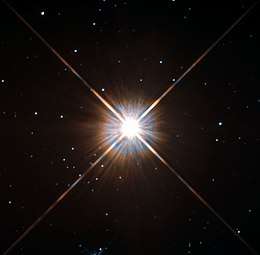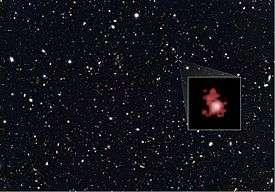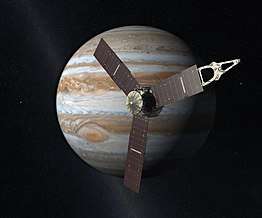Proxima Centauri b
Proxima Centauri b (also called Proxima b[5][6] or Alpha Centauri Cb) is an exoplanet orbiting in the habitable zone of the red dwarf star Proxima Centauri, which is the closest star to the Sun and part of a triple star system.[7][8] It is located approximately 4.2 light-years (4.0×1013 km) from Earth in the constellation of Centaurus, making it the closest known exoplanet to the Solar System.
 Artist's conception of Proxima Centauri b as a rocky-like exoplanet, with Proxima Centauri and the Alpha Centauri binary system in the background. The actual appearance of the planet is unknown. | |
| Discovery | |
|---|---|
| Discovered by | Anglada-Escudé et al. |
| Discovery site | European Southern Observatory |
| Discovery date | 24 August 2016 |
| Doppler spectroscopy | |
| Orbital characteristics | |
| 0.0485+0.0041 −0.0051 AU | |
| Eccentricity | 0.124+0.070 −0.068 |
| 11.18427+0.00066 −0.00070[1] d | |
| 310 (± 50)[2] | |
| Semi-amplitude | 1.38 (± 0.21)[2] |
| Star | Proxima Centauri |
| Physical characteristics | |
Mean radius | 1.07+0.38 −0.31[3]R⊕, 1.30+1.20 −0.62[4]R⊕ |
| Mass | 1.172+1.66 −0.72[3]M⊕, 1.60+0.46 −0.36[4]M⊕ |
| ~1.1 g, ~0.95 g | |
| Temperature | 234 K (−39 °C; −38 °F) |
Proxima Centauri b orbits the star at a distance of roughly 0.05 AU (7,500,000 km; 4,600,000 mi) with an orbital period of approximately 11.2 Earth days, and has an estimated mass of at least 1.2 times that of the Earth. The planet is subject to stellar wind pressures of more than 2,000 times those experienced by Earth from the solar wind and the habitability of Proxima Centauri b has not yet been definitively established.[9][10][11]
The discovery of the planet was announced in August 2016.[7][2] The planet was found using the radial velocity method, where periodic Doppler shifts of spectral lines of the host star suggest an orbiting object. From these readings, the radial velocity of the parent star relative to the Earth is varying with an amplitude of about 1.4 metres (4.5 feet) per second.[2] According to Guillem Anglada‐Escudé, its proximity to Earth offers an opportunity for robotic exploration of the planet with the Starshot project[7][8] or, at least, "in the coming centuries".[8]
Without its orbital inclination known, the exact mass of Proxima Centauri b is unknown. If its orbit is nearly edge-on, it would have a mass of 1.173±0.086[1] Earth masses. Statistically, there is a roughly 90% chance that the planet's mass is less than 2.77 M⊕ (Earth masses).[1][12]
In May 2019, a paper presenting recent Spitzer Space Telescope data concluded that Proxima Centauri b does not transit its sun relative to Earth, and attributed previous transit detections to correlated noise.[13]
Physical characteristics
Mass, radius, and temperature
The apparent inclination of Proxima Centauri b's orbit has not yet been measured. The minimum mass of Proxima b is 1.17 M⊕, which would be the actual mass if its orbit were seen edge on from the Earth.[1] Once its orbital inclination is known, the mass will be calculable. More tilted orientations imply a higher mass, with 90% of possible orientations implying a mass below 2.77 M⊕.[1] The planet's exact radius is unknown. If it has a rocky composition and a density equal to that of the Earth, then its radius is at least 1.1 R⊕. It could be larger if it has a lower density than the Earth, or a mass higher than the minimum mass.[14] Like many super-Earth sized planets, Proxima Centauri b might have an icy composition like Neptune, with a thick enveloping, hydrogen and helium atmosphere; the likelihood that this is the case has been calculated to be greater than 10%.[3] The planet has an equilibrium temperature of 234 K (−39 °C; −38 °F)[2], somewhat colder than Earth’s 255 K (−18 °C; −1 °F).[15]
If the orbit of Proxima Centauri b is coplanar with that of the candidate exoplanet Proxima Centauri c, for which estimates of the true mass were recently calculated using various combinations of its spectroscopic orbital parameters, Gaia DR2 proper motion anomaly, and astrometric measurements, then a true mass of Proxima b can be estimated. For example, in 2020, a paper published by Kervella et al. estimated 2.1+1.9
−0.6 Earth masses,[16] and another by Benedict et al. estimated 3.0±0.3 Earth masses,[17] as true mass values for Proxima b.
Host star
The planet orbits an M-type red dwarf named Proxima Centauri. The star has a mass of 0.12 M☉ and a radius of 0.14 R☉.[2] It has a surface temperature of 3042 K [18] and is 4.85 billion years old.[19] In comparison, the Sun is 4.6 billion years old [20] and has a surface temperature of 5778 K.[21] Proxima Centauri rotates once roughly every 83 days,[22] and has a luminosity about 0.0015 L☉.[2] Like the two larger stars in the triple star system, Proxima Centauri is rich in metals compared with the Sun, something not normally found in low-mass stars like Proxima. Its metallicity ([Fe/H]) is 0.21, or 1.62 times the amount found in the Sun's atmosphere.[23][note 1]
Even though Proxima Centauri is the closest star to the Sun, it is not visible to the unaided eye from Earth because of its low luminosity (average apparent magnitude of 11.13[24]).
Proxima Centauri is a flare star.[25] This means that it undergoes occasional dramatic increases in brightness and high-energy emissions because of magnetic activity that would create large solar storms. On 18 March 2016, a superflare was observed with an energy of 1026.5 joules.[26] The March 2016 flare reached about 68 times usual level, thus a little brighter than the Sun.[27] The surface irradiation was estimated to be 100 times what is required to kill even UV-hardy microorganisms. Based on the rate of observed flares, total ozone depletion of an Earth-like atmosphere would occur within several hundred thousand years.[28][29]
Orbit
Proxima Centauri b orbits its host star every 11.186 days at a semi-major axis distance of approximately 0.05 astronomical units (7,000,000 km; 5,000,000 mi), which means the distance from the exoplanet to its host star is one-twentieth of the distance from the Earth to the Sun.[2] Comparatively, Mercury, the closest planet to the Sun, has a semi-major axis distance of 0.39 AU. Proxima Centauri b receives about 65% of the amount of radiative flux from its host star that the Earth receives from the Sun – for comparison, Mars receives about 43%. Most of the radiative flux from Proxima Centauri is in the infrared spectrum. In the visible spectrum the exoplanet receives only ~3% of the PAR (400–700 nm) of Earth irradiance – for comparison, Jupiter receives 3.7% and Saturn 1.1%.[30] – so it would usually not get much brighter than twilight anywhere on Proxima Centauri b's surface. The maximum illumination of horizontal ground by twilight at sunrise is about 400 lux,[31] while the illumination of Proxima b is about 2700 lux with quiet Proxima. Proxima also has flares. The brightest flare observed until 2016 had increased the visual brightness of Proxima about 8 times, which would be a large change from the previous level but, at about 17% the illumination of Earth, not very strong sunlight.[note 2] However, because of its tight orbit, Proxima Centauri b receives about 400 times more X-ray radiation than the Earth does.[2]
Habitability
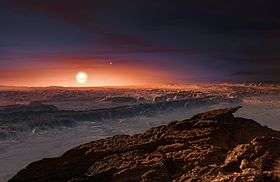
The habitability of Proxima Centauri b has not been established,[9][10] but the planet is subject to stellar wind pressures of more than 2,000 times those experienced by Earth from the solar wind.[9][32] This radiation and the stellar winds would likely blow any atmosphere away, leaving the undersurface as the only potentially habitable location on that planet.[29][33]
The exoplanet is orbiting within the habitable zone of Proxima Centauri, the region where, with the correct planetary conditions and atmospheric properties, liquid water may exist on the surface of the planet. The host star, with about an eighth of the mass of the Sun, has a habitable zone between ∼0.0423–0.0816 AU.[2] In October 2016, researchers at France's CNRS research institute stated that there is a considerable chance of the planet harboring surface oceans and having a thin atmosphere.[34] However, unless the planet transits in front of its star from the perspective of Earth, it is difficult to test these hypotheses.
Even though Proxima Centauri b is in the habitable zone, the planet's habitability has been questioned because of several potentially hazardous physical conditions. The exoplanet is close enough to its host star that it might be tidally locked.[35] In this case, it is expected that any habitable areas would be confined to the border region between the two extreme sides, generally referred to as the terminator line, since it is only here that temperatures might be suitable for liquid water to exist.[36] If the planet's orbital eccentricity is 0, this could result in synchronous rotation, with one hot side permanently facing towards the star, while the opposite side is in permanent darkness and freezing cold.[37][38] However, Proxima Centauri b's orbital eccentricity is not known with certainty, only that it is below 0.35—potentially high enough for it to have a significant chance of being captured into a 3:2 spin-orbit resonance similar to that of Mercury, where Proxima b would rotate around its axis approximately every 7.5 Earth days with about 22.4 Earth days elapsing between one sunrise and the next.[11][39][40] Resonances as high as 2:1 are also possible.[11][40] Another problem is that the flares released by Proxima Centauri could have eroded the atmosphere of the exoplanet. However, if Proxima b had a strong magnetic field, the flare activity of its parent star would not be a problem.[2]
If water and an atmosphere are present, a far more hospitable environment would result. Assuming an atmospheric N2 pressure of 1 bar and ∼0.01 bar of CO2, in a world including oceans with average temperatures similar to those on Earth, a wide equatorial belt (non-synchronous rotation), or the majority of the sunlit side (synchronous rotation), would be permanently ice-free.[40][41] A large portion of the planet may be habitable if it has an atmosphere thick enough to transfer heat to the side facing away from the star.[36] If it has an atmosphere, simulations suggest that the planet could have lost about as much as the amount of water that Earth has due to the early irradiation in the first 100–200 million years after the planet's formation. Liquid water may be present only in the sunniest regions of the planet's surface in pools either in an area in the hemisphere of the planet facing the star or—if the planet is in a 3:2 resonance rotation—diurnally in the equatorial belt.[11][40] All in all, astrophysicists consider the ability of Proxima Centauri b to retain water from its formation as the most crucial point in evaluating the planet's present habitability.[42] The planet may be within reach of telescopes and techniques that could reveal more about its composition and atmosphere, if it has any.[9]
If the atmosphere is indeed present, longer-wavelength incoming radiation of red dwarf parent star mean the clouds formation on dayside will be difficult compared to the Earth or Venus, resulting in more clear sky weather.[43]
View from Proxima Centauri b

Viewed from near the Alpha Centauri system, the sky would appear much as it does for an observer on Earth, except that Centaurus would be missing its brightest star. The Sun would be a yellow star of an apparent magnitude of +0.5 in eastern Cassiopeia, at the antipodal point of Alpha Centauri's current right ascension and declination, at 02h 39m 35s +60° 50′ (2000). This place is close to the 3.4-magnitude star ε Cassiopeiae. Because of the placement of the Sun, an interstellar or alien observer would find the \/\/ of Cassiopeia had become a /\/\/ shape[note 3] nearly in front of the Heart Nebula in Cassiopeia. Sirius lies less than a degree from Betelgeuse in the otherwise unmodified Orion and with a magnitude of −1.2 is a little fainter than from Earth but still the brightest star in the Alpha Centauri sky. Procyon is also displaced into the middle of Gemini, outshining Pollux, whereas both Vega and Altair are shifted northwestward relative to Deneb (which barely moves, due to its great distance), giving the Summer Triangle a more equilateral appearance.
From Proxima Centauri b, Alpha Centauri AB would appear like two close bright stars with the combined apparent magnitude of −6.8. Depending on the binary's orbital position, the bright stars would appear noticeably divisible to the naked eye, or occasionally, but briefly, as a single unresolved star. Based on the calculated absolute magnitudes, the apparent magnitudes of Alpha Centauri A and B would be −6.5 and −5.2, respectively.[note 4]
Formation
It is unlikely that Proxima Centauri b originally formed in its current orbit since disk models for small stars like Proxima Centauri would contain less than one Earth mass M⊕ of matter within the central one AU at the time of their formation. This implies that either Proxima Centauri b was formed elsewhere in a manner still to be determined, or the current disc models for stellar formation are in need of revision.[2]
Discovery
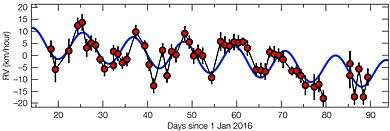
The first indications of the exoplanet were found in 2013 by Mikko Tuomi of the University of Hertfordshire from archival observation data.[22][44] To confirm the possible discovery, a team of astronomers launched the Pale Red Dot[note 5] project in January 2016.[45] On 24 August 2016, the team of 31 scientists from all around the world,[46] led by Guillem Anglada-Escudé of Queen Mary University of London, confirmed the existence of Proxima Centauri b[19] through their research, published in a peer-reviewed article in Nature.[47][2][35][48][49][50]
The measurements were done using two spectrographs, HARPS on the ESO 3.6 m Telescope at La Silla Observatory and UVES on the 8-metre Very Large Telescope.[2] The peak radial velocity of the host star combined with the orbital period allowed for the minimum mass of the exoplanet to be calculated. The chance of a false positive detection is less than one in ten million.[22]
Observational complications of the system still leave theoretical room for additional large planets to orbit Proxima Centauri. Calculations suggest that another super-Earth planet around the star cannot be ruled out and that its presence would not destabilize the orbit of Proxima Centauri b.[2]
Data collected with ESPRESSO excludes the presence of extra companions with masses above 0.6 Me at periods shorter than 50 days.[1]
Future observations

A team of scientists think they can image Proxima Centauri b and probe the planet's atmosphere for signs of oxygen, water vapor, and methane, combining ESPRESSO and SPHERE on the VLT.[52] The James Webb Space Telescope may be able to characterize the atmosphere of Proxima Centauri b,[53] but there is no conclusive evidence for transits combining MOST and HATSouth photometry, giving it less than a 1 percent chance of being a transiting planet.[54] Future telescopes (the Extremely Large Telescope, the Giant Magellan Telescope, and the Thirty Meter Telescope) could have the capability to characterize Proxima Centauri b.
The discovery of Proxima b was significant to Breakthrough Starshot, a proof of concept project aiming to send a fleet of miniature probes to the Alpha Centauri system.[55] The project is led by research company Breakthrough Initiatives, and plans to develop and launch a fleet of miniature unmanned spacecraft called StarChips,[56] which could travel at up to 20% of the speed of light,[57][58] arriving at the system in roughly 20 years with notification reaching Earth a little over 4 years later.[7]
2069 Alpha Centauri mission
In 2017, Breakthrough Initiatives and the European Southern Observatory (ESO) entered a collaboration to enable and implement a search for habitable planets in the nearby star system, Alpha Centauri. The agreement involves Breakthrough Initiatives providing funding for an upgrade to the VISIR (VLT Imager and Spectrometer for mid-Infrared) instrument on ESO's Very Large Telescope (VLT) in Chile.[51]
Diagrams

An angular size comparison of how Proxima will appear in the sky seen from Proxima b, compared with how the Sun appears in our sky on Earth. Proxima is much smaller than the Sun, but Proxima b is very close to its star. .tif.jpg)
The relative sizes of a number of objects, including the three stars of the Alpha Centauri triple system and some other stars for which the angular sizes have also been measured. The Sun and Jupiter are also shown for comparison. 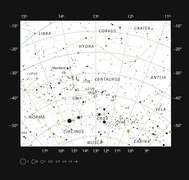
This chart shows the large southern constellation of Centaurus (the Centaur) and shows most of the stars visible with the naked eye on a clear dark night. The location of the closest star to the Solar System, Proxima Centauri, is marked with a red circle. Proxima Centauri is too faint to see with the unaided eye but can be found using a small telescope. 
This picture combines a view of the southern skies over the ESO 3.6-metre telescope at the La Silla Observatory in Chile with images of the stars Proxima Centauri (lower-right) and the double star Alpha Centauri AB (lower-left) from the NASA/ESA Hubble Space Telescope. Proxima Centauri is the closest star to the Solar System and is orbited by the planet Proxima b.
Videos
See also
- Alpha Centauri
- Alpha Centauri Bb – exoplanet once proposed to be orbiting the secondary star of the system, Alpha Centauri B, and was dubbed the closest exoplanet for a while before being disproven
- Astrobiology
- Breakthrough Starshot
- Colossus Telescope
- Exoplanetology
- List of potentially habitable exoplanets
- Proxima Centauri
Notes
- Taken from 100.21, which gives 1.62 times the metallicity of the Sun
- From knowing the absolute visual magnitude of Proxima Centauri, , and the absolute visual magnitude of the Sun, , the visual luminosity of Proxima Centauri can be calculated: = 4.92×10−5. Proxima Centauri b orbits at 0.0485 AU and so therefore, through use of the inverse-square law, the visual luminosity—intensity at the planet's distance—can be calculated:
- The coordinates of the Sun would be diametrically opposite Alpha Centauri AB, at α= 02h 39m 36.4951s, δ=+60° 50′ 02.308″
- Computed; using in solar terms: 1.1 M☉ and 0.92 M☉, luminosities 1.57 and 0.51 L*/L☉, Sun magnitude −26.73(v), 11.2 to 35.6 AU orbit. The minimum luminosity adds the planet's orbital radius to the A–B distance (max) (conjunction). The maximum luminosity subtracts the planet's orbital radius to the A–B distance (min) (opposition).
- Pale Red Dot is a reference to Pale Blue Dot—a distant photo of Earth taken by Voyager 1.
References
- Suárez Mascareño, A.; Faria, J. P.; Figueira, P.; Lovis, C.; Damasso, M.; González Hernández, J. I.; Rebolo, R.; Cristiano, S.; Pepe, F.; Santos, N. C.; Zapatero Osorio, M. R.; Adibekyan, V.; Hojjatpanah, S.; Sozzetti, A.; Murgas, F.; Abreo, M.; Affolter, M.; Alibert, Y.; Aliverti, M.; Allart, R.; Allende Prieto, C.; Alves, D.; Amate, M.; Avila, G.; Baldini, V.; Bandi, T.; Barros, S. C. C.; Bianco, A.; Benz, W.; et al. (2020). "Revisiting Proxima with ESPRESSO". arXiv:2005.12114 [astro-ph.EP].
- Anglada-Escudé G, Amado PJ, Barnes J, Berdiñas ZM, Butler RP, Coleman GA, de la Cueva I, Dreizler S, Endl M, Giesers B, Jeffers SV, Jenkins JS, Jones HR, Kiraga M, Kürster M, López-González MJ, Marvin CJ, Morales N, Morin J, Nelson RP, Ortiz JL, Ofir A, Paardekooper S, Reiners A, Rodríguez E, Rodriguez-López C, Sarmiento LF, Strachan JP, Tsapras Y, Tuomi M, Zechmeister M (25 August 2016). "A terrestrial planet candidate in a temperate orbit around Proxima Centauri" (PDF). Nature. 536 (7617): 437–440. arXiv:1609.03449. Bibcode:2016Natur.536..437A. doi:10.1038/nature19106. ISSN 0028-0836. PMID 27558064.
- Bixel, A.; Apai, D. (21 February 2017). "Probabilistic Constraints on the Mass and Composition of Proxima b". The Astrophysical Journal Letters. 836 (2): L31. arXiv:1702.02542. Bibcode:2017ApJ...836L..31W. doi:10.3847/2041-8213/aa5f51. ISSN 2041-8205.
- Tasker, Elizabeth J.; Laneuville, Matthieu; Guttenberg, Nicholas (7 January 2020). "Estimating Planetary Mass with Deep Learning". The Astronomical Journal. 159 (2): 41. arXiv:1911.11035. Bibcode:2020AJ....159...41T. doi:10.3847/1538-3881/ab5b9e. ISSN 1538-3881.
- "Earth-like planet discovered orbiting sun's neighbor". CNN. 24 August 2016. Retrieved 24 August 2016.
A planet named Proxima b has been discovered orbiting the closest star to our sun.
- Davis, Nicola (24 August 2016). "Discovery of potentially Earth-like planet Proxima b raises hopes for life". The Guardian. Archived from the original on 14 April 2019. Retrieved 24 August 2016.
- Chang, Kenneth (24 August 2016). "One Star Over, a Planet That Might Be Another Earth". The New York Times. Archived from the original on 26 June 2019. Retrieved 24 August 2016.
- Strickland, Ashley (24 August 2016). "Closest potentially habitable planet to our solar system found". CNN. Archived from the original on 30 August 2016. Retrieved 25 August 2016.
- Clery, Daniel (26 August 2016). "The exoplanet next door". Science. 353 (6302): 857. Bibcode:2016Sci...353..857C. doi:10.1126/science.353.6302.857. PMID 27563079.
Researchers have already found hundreds of similarly sized planets, and many appear to be far better candidates for hosting life than the one around Proxima Centauri, called Proxima b.
- Amos, Jonathan (24 August 2016). "Neighbouring star Proxima Centauri has Earth-sized planet". BBC News. Archived from the original on 24 August 2016. Retrieved 25 August 2016.
Just how "habitable" this particular planet really is, one has to say is pure speculation for the time being.
- Ribas, Ignasi; Bolmont, Emeline; Selsis, Franck; Reiners, Ansgar; et al. (25 August 2016). "The habitability of Proxima Centauri b: I. Irradiation, rotation and volatile inventory from formation to the present" (PDF). Astronomy & Astrophysics. 596: A111. arXiv:1608.06813. Bibcode:2016A&A...596A.111R. doi:10.1051/0004-6361/201629576. Archived (PDF) from the original on 2 May 2019.
- Marchis, Franck (24 August 2016). "Proxima Centauri b: Have we just found Earth's cousin right on our doorstep?". The Planetary Society. Archived from the original on 7 June 2019. Retrieved 24 August 2016.
- Jenkins, James S.; Harrington, Joseph; Challener, Ryan C.; Kurtovic, Nicolás T.; et al. (11 May 2019). "Proxima Centauri b is not a transiting exoplanet". Monthly Notices of the Royal Astronomical Society. 487 (1): 268–274. arXiv:1905.01336. Bibcode:2019MNRAS.487..268J. doi:10.1093/mnras/stz1268.
- Mendez, Abel (17 August 2016). "A Potentially Habitable World in Our Nearest Star". Planetary Habitability Laboratory (Press release). University of Puerto Rico at Arecibo. Archived from the original on 2 May 2019.
- "Equilibrium Temperatures of Planets". burro.astr.cwru.edu. Retrieved 1 August 2013.
- Kervella, Pierre; et al. (2020). "Orbital inclination and mass of the exoplanet candidate Proxima c". Astronomy & Astrophysics. 635: L14. arXiv:2003.13106. Bibcode:2020A&A...635L..14K. doi:10.1051/0004-6361/202037551. ISSN 0004-6361.
If we assume the coplanarity of the orbits of the planets Proxima b and c, the de-projected mass of the close-in planet is mb = 2.1+1.9
−0.6 M⊕ (adopting mb sin i = 1.0±0.1 M⊕ from Damasso et al. 2020). - Benedict, G. Fritz; et al. (2020). "A Preliminary Mass for Proxima Centauri C". Research Notes of the AAS. 4 (4): 46. Bibcode:2020RNAAS...4...46B. doi:10.3847/2515-5172/ab84f3. ISSN 2515-5172.
Assuming a coplanar system, Proxima b would have Mb = 3 ± 0.3 M⊕
- Ségransan, D.; Kervella, P.; Forveille, T.; Queloz, D. (2003). "First radius measurements of very low mass stars with the VLTI". Astronomy and Astrophysics. 397 (3): L5–L8. arXiv:astro-ph/0211647. Bibcode:2003A&A...397L...5S. doi:10.1051/0004-6361:20021714.
- Mathewson, Samantha (24 August 2016). "Proxima b By the Numbers: Possibly Earth-Like World at the Next Star Over". Space.com. Archived from the original on 16 November 2018. Retrieved 25 August 2016.
- Cain, Fraser (16 September 2008). "How Old is the Sun?". Universe Today. Archived from the original on 18 August 2010. Retrieved 19 February 2011.
- Cain, Fraser (15 September 2008). "Temperature of the Sun". Universe Today. Archived from the original on 29 August 2010. Retrieved 19 February 2011.
- "Proxima b is our neighbor… better get used to it!". Pale Red Dot. 24 August 2016. Archived from the original on 31 March 2019. Retrieved 24 August 2016.
- Schlaufman, Kevin C.; Laughlin, Gregory (September 2010). "A physically-motivated photometric calibration of M dwarf metallicity". Astronomy and Astrophysics. 519: A105. arXiv:1006.2850. Bibcode:2010A&A...519A.105S. doi:10.1051/0004-6361/201015016.
- Jao, Wei-Chun; Henry, Todd J.; Subasavage, John P.; Winters, Jennifer G.; et al. (January 2014). "The Solar Neighborhood. XXXI. Discovery of an Unusual Red+White Dwarf Binary at ~25 pc via Astrometry and UV Imaging". The Astronomical Journal. 147 (1): 21. arXiv:1310.4746. Bibcode:2014AJ....147...21J. doi:10.1088/0004-6256/147/1/21. ISSN 0004-6256.
- Christian, D. J.; Mathioudakis, M.; Bloomfield, D. S.; Dupuis, J.; Keenan, F. P. (2004). "A Detailed Study of Opacity in the Upper Atmosphere of Proxima Centauri" (PDF). The Astrophysical Journal. 612 (2): 1140–1146. Bibcode:2004ApJ...612.1140C. doi:10.1086/422803. Archived (PDF) from the original on 10 July 2019.
- Williams, Matt (10 April 2018). "Proxima Centauri Just Released a Flare so Powerful it was Visible to the Unaided Eye. Planets There Would Get Scorched". Universe Today. Archived from the original on 31 March 2019. Retrieved 17 January 2019.
- Howard, Ward S.; Tilley, Matt A.; Corbett, Hank; Youngblood, Allison; et al. (25 June 2018). "The First Naked-eye Superflare Detected from Proxima Centauri". The Astrophysical Journal Letters. 860 (2): L30. arXiv:1804.02001. Bibcode:2018ApJ...860L..30H. doi:10.3847/2041-8213/aacaf3.
- Airapetian, Vladimir S.; Glocer, Alex; et al. (2017). "How Hospitable Are Space Weather Affected Habitable Zones? The Role of Ion Escape". The Astrophysical Journal. 836 (1): L3. Bibcode:2017ApJ...836L...3A. doi:10.3847/2041-8213/836/1/L3.
- Rodriguez-Mozos, J. M.; Moya, A. (August 2019). "Erosion of an exoplanetary atmosphere caused by stellar winds". Astronomy & Astrophysics. 630. Table A.4. arXiv:1908.06695. Bibcode:2019A&A...630A..52R. doi:10.1051/0004-6361/201935543.
- Ritchie, Raymond J.; Larkum, Anthony W. D.; Ribas, Ignasi (April 2018). "Could photosynthesis function on Proxima Centauri b?". International Journal of Astrobiology. 17 (2): 147–176. Bibcode:2018IJAsB..17..147R. doi:10.1017/S1473550417000167. Retrieved 10 September 2018.
- Schlyter, Paul (5 March 2017). "Radiometry and photometry in astronomy". stjarnhimlen.se. Stockholm, Sweden. 10: How bright are natural light sources?. Retrieved 21 June 2017.
- Garraffo, Cecilia; Drake, Jeremy J.; Cohen, Ofer (28 September 2016). "The Space Weather of Proxima Centauri b". The Astrophysical Journal Letters. 833 (1): L4. arXiv:1609.09076. Bibcode:2016ApJ...833L...4G. doi:10.3847/2041-8205/833/1/L4.
- O'Neill, Ian (7 October 2016). "Eyeballing Proxima b: Probably Not a Second Earth". Space.com. Archived from the original on 10 July 2019. Retrieved 10 October 2016.
- "Planet in star system nearest our Sun 'may have oceans'". Phys.org. AFP. 6 October 2016. Archived from the original on 17 April 2019. Retrieved 6 October 2016.
- Witze, Alexandra (24 August 2016). "Earth-sized planet around nearby star is astronomy dream come true" (PDF). Nature. 536 (7617): 381–382. Bibcode:2016Natur.536..381W. doi:10.1038/nature.2016.20445. PMID 27558041. Retrieved 24 August 2016.
- Singal, Ashok K. (2014). "Life on a tidally-locked planet". Planex Newsletter. 4 (2): 8. arXiv:1405.1025. Bibcode:2014arXiv1405.1025S.
- Barnes, Rory, ed. (2010). Formation and Evolution of Exoplanets. John Wiley & Sons. p. 248. ISBN 978-3527408962.
- Heller, R.; Leconte, J.; Barnes, R. (April 2011). "Tidal obliquity evolution of potentially habitable planets". Astronomy & Astrophysics. 528: A27. arXiv:1101.2156. Bibcode:2011A&A...528A..27H. doi:10.1051/0004-6361/201015809.
- Makarov, Valeri V. (25 May 2012). "Conditions of Passage and Entrapment of Terrestrial Planets in Spin-orbit Resonances". The Astrophysical Journal. 752 (1): 73. arXiv:1110.2658. Bibcode:2012ApJ...752...73M. doi:10.1088/0004-637X/752/1/73.
- Turbet, Martin; Leconte, Jeremy; Selsis, Franck; Bolmont, Emeline; et al. (28 September 2016). "The habitability of Proxima Centauri b II. Possible climates and observability" (PDF). Astronomy & Astrophysics. 596: A112. arXiv:1608.06827. Bibcode:2016A&A...596A.112T. doi:10.1051/0004-6361/201629577. Retrieved 25 August 2016.
- Turbet, M.; Ribas, I. (24 August 2016). "Numerical simulation of possible surface temperatures on Proxima b (synchronous rotation)". European Southern Observatory. Retrieved 24 August 2016.
- Barnes, Rory; Deitrick, Russell; Luger, Rodrigo; Driscoll, Peter E.; et al. (24 August 2016). "The Habitability of Proxima Centauri b I: Evolutionary Scenarios". Astrobiology. 1608: 62. arXiv:1608.06919. Bibcode:2016arXiv160806919B.
- Eager, Jake K.; Reichelt, David J.; Mayne, Nathan J.; Hugo Lambert, F.; Sergeev, Denis E.; Ridgway, Robert J.; Manners, James; Boutle, Ian A.; Lenton, Timothy M.; Kohary, Krisztian (2020). "Implications of different stellar spectra for the climate of tidally-locked Earth-like exoplanets". arXiv:2005.13002 [astro-ph.EP].
- Aron, Jacob (24 August 2016). "Proxima b: Earth-like planet spotted just 4 light years away". New Scientist. Archived from the original on 20 September 2016. Retrieved 24 August 2016.
- "Follow a Live Planet Hunt!". European Southern Observatory. 15 January 2016. Archived from the original on 9 June 2019. Retrieved 24 August 2016.
- Feltman, Rachel (24 August 2016). "Scientists say they've found a planet orbiting Proxima Centauri, our closest neighbor". The Washington Post. Archived from the original on 7 September 2016.
- "Planet Found in Habitable Zone Around Nearest Star – Pale Red Dot campaign reveals Earth-mass world in orbit around Proxima Centauri". European Southern Observatory. 24 August 2016. Archived from the original on 21 March 2019. Retrieved 10 January 2017.
- "Planet Found in Habitable Zone Around Nearest Star". European Southern Observatory. 24 August 2016. Archived from the original on 9 July 2019.
- Wall, Mike (24 August 2016). "Found! Potentially Earth-Like Planet at Proxima Centauri Is Closest Ever". Space.com. Archived from the original on 3 July 2019.
- Knapton, Sarah (24 August 2016). "Proxima b: Alien life could exist on 'second Earth' found orbiting our nearest star in Alpha Centauri system". The Telegraph. Archived from the original on 26 August 2016. Retrieved 24 August 2016.
- "VLT to Search for Planets in Alpha Centauri System – ESO Signs Agreement with Breakthrough Initiatives" (Press release). ESO. Archived from the original on 27 April 2019. Retrieved 10 January 2017.
- Lovis, C.; Snellen, I.; Mouillet, D.; Pepe, F.; et al. (March 2017). "Atmospheric characterization of Proxima b by coupling the SPHERE high-contrast imager to the ESPRESSO spectrograph". Astronomy & Astrophysics. 599: A16. arXiv:1609.03082. Bibcode:2017A&A...599A..16L. doi:10.1051/0004-6361/201629682.
- Kreidberg, Laura; Loeb, Abraham (15 November 2016). "Prospects for Characterizing the Atmosphere of Proxima Centauri b". The Astrophysical Journal. 832 (1): L12. arXiv:1608.07345. Bibcode:2016ApJ...832L..12K. doi:10.3847/2041-8205/832/1/L12.
- Kipping, David M.; Cameron, Chris; Hartman, Joel D.; Davenport, James R. A.; et al. (2 February 2017). "No Conclusive Evidence for Transits of Proxima b in MOST Photometry". The Astronomical Journal. 153 (3): 93. arXiv:1609.08718. Bibcode:2017AJ....153...93K. doi:10.3847/1538-3881/153/3/93.
- "Starshot". Breakthrough Initiatives. 12 April 2016. Archived from the original on 22 May 2019. Retrieved 12 April 2016.
- Gilster, Paul (12 April 2016). "Breakthrough Starshot: Mission to Alpha Centauri". Centauri Dreams. Retrieved 14 April 2016.
- Overbye, Dennis (12 April 2016). "Reaching for the Stars, Across 4.37 Light-Years; A Visionary Project Aims for Alpha Centauri, a Star 4.37 Light-Years Away". The New York Times. Archived from the original on 15 April 2016. Retrieved 12 April 2016.
- Stone, Maddie (12 April 2016). "Stephen Hawking and a Russian Billionaire Want to Build an Interstellar Starship". Gizmodo. Archived from the original on 30 May 2019. Retrieved 12 April 2016.
Further reading
- Calandrelli E, Escher A (16 December 2016). "The top 15 events that happened in space in 2016". TechCrunch. Retrieved 16 December 2016.
External links
| Wikimedia Commons has media related to Proxima Centauri b. |
